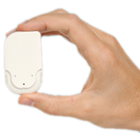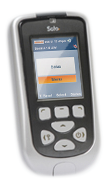The SOLO MicroPump Insulin Delivery System is a patch pump originally made by Medingo and purchased by Roche in 2010. Solo received FDA approval in 2009 and is expected to be available in 2012. The system has 4 parts: a micropump composed of reusable electronics plus an insulin reservoir, a remote, and a cradle.
The Cradle

The cradle takes the place of your standard infusion set. Insertion is easy with the SOLO inserter. The cradle attaches to to your body with an adhesive that holds it in place. It can be placed in any of the normal infusion sites such as your abdomen, buttocks, upper thighs and upper arms. After placing it where you want it, push one button on the inserter, the cannula is inserted and the cradle is ready for use. You can easily click the micropump in and out of the cradle to quickly attach and detach. This is particularly important since the pump is not waterproof. The pump site is changed regularly as you would a normal infusion site.
The Pump

The micropump is actually 2 parts that snap together, with a total size of 2.4 x 1.5 x 0.5 inches (6.1 x 3.8 x 1.3 cm). One part is a disposable 200 unit insulin reservoir. Changing it every 2 or 3 days is suggested, depending on your total daily dose of insulin. The reservoir is transparent so you can see how much insulin is left and view any potential site problems. It also holds the dispensing mechanism and a battery for the pump base. A separate device is used to refill the reservoir.
The pump base is the second part. It contains all of the brains of the pump: the electronics, memory, pump motor and a buzzer. It stores all your pump settings, including basal rate and bolus factors. It is designed to last 90 days before you need to change to a new one. You receive a spare in case of any problems with your main pump base. Tactile bolus buttons allow you to bolus from the pump on your body.
One advantage to Solo’s modular approach is that it is much greener. For example, with Omnipod, the entire patch pump is thrown away every 2 or 3 days. Each disposable pump has four 357 battery and a circuit board. This means every year, 119 to 178 circuit boards and 426 to 712 batteries are thrown in the trash (or recycled). This is largely eliminated with modular patch pumps. It also provides a significant economic advantage.
The Remote

The remote is about the size of a smartphone at 4.2 x 2.2 x 1.0 inches (10.6 x 5.6 x 2.5 cm). It has a color screen but keeps tactile buttons, unlike some of the newer patch pump controllers being developed that use touch screen interfaces similar to the smartphones on the market. You can input your settings with the remote and download them to the pump. Boluses can be given with the bolus buttons on the pump (what they call Bolus on Demand) or directly from the remote. Your pump settings in both places.
The remote also gives you access to other nice features. The bolus calculator, called the SOLO Bolus Guide, will help you figure out how much insulin to take for highs or meals and keep track of your Bolus on Board. You can also see a 90-day history including blood glucose trend graphs, average daily dose data and delivery details on the remote.
I’m curious how the communication between the two devices work, specifically if the information is passed back and forth between them automatically via syncing. For instance, if I bolus using the buttons on the pump while my remote is not near me, will that bolus information be passed on to the remote next time they are close enough to “speak?” If so, this allows graphing and record-keeping to remain accurate even if the remote is forgotten or misplaced.
Bolus Calculator
Unlike other pumps currently on the market, the Solo bolus calculator was designed to give the safest bolus doses possible. Bolus doses were determined as carb bolus plus correction bolus minus BOB. Roche’s other pumps use a complicated and less accurate bolus calculator based on the current glucose level where insulin stacking may occur. Hopefully, Roche will keep Solo’s safer bolus algorithm even though it differs from its other pumps.
Cost
Medingo has mentioned a “pay as you pump” feature in the past. There hasn’t been any more information released about it but it sounds like the upfront cost will be reduced. This may have more appeal to insurers and individuals who want to try this pump. The recurring fee would hopefully include ongoing costs like reordering supplies as well.
So where is it?
Already cleared by the FDA, Roche reports that the Solo should be available in the US in 2012. Let’s keep our fingers crossed.
| Solo MicroPump | |
|---|---|
| Dimensions | 2.4 x 1.5 x 0.5 inches (6.1 x 3.8 x 1.3 cm) |
| Weight with a full reservoir | 0.85 oz (24 gr) |
| Pump base | 3-month life after initial pairing |
| Occlusion & other safety alarms | Audible on micropump |
| On-pump bolus buttons | Can be customized and disabled |
| Detachable/re-attachable | Yes, by disconnecting from cradle |
| Reservoir | |
| Reservoir Capacity | 200 units of U100 insulin (Min. 70 units) |
| Reservoir Description | Transparent with volume fill lines |
| Reservoir Filling Device | No syringe needed |
| Use Rapid Acting Insulins | Humalog®, NovoLog®/ NovoRapid®, Apidra® |
| Reservoir Change Frequency | 3 days NovoLog®/ NovoRapid®(based on insulin manufacturer labeling) |
| Cannula cradle infusion set | |
| Cannula | 9 mm, 90° insertion; soft Teflon® |
| Insertion needle | 27 gauge; hidden from view |
| Automated inserter | Virtually painless, auto-needle retraction |
| Adhesive | Hypafix®- hypoallergenic, latex-free |
| Change frequency | 2-3 days |
| Site change reminder | Yes |
| Allows disconnection | Yes |
| Remote | |
| Dimensions | 4.2 x 2.2 x 1.0 inches (10.6 x 5.6 x 2.5 cm) |
| Weight with batteries | 5.2 oz (148 gr) |
| Batteries | 2 AA alkaline |
| Guided procedures | Start-up; reservoir replacement, micropump replacement, priming, Bolus Guide |
| Safety lock-out | Auto keypad lock |
| Flexible programming | Reminders and alerts |
| Remote screen | Large, backlit, color graphics |
| Status bar and screen | Current updates from micropump |
| Color panels | Multiple (7) color choices |
| Remote notifications | User-selected –audible, vibrate or both |
| Communication distance | 5 feet (1.5 meters) |
| Soft keys | User-selectable based on frequent use |
| Basal delivery options | |
| Basal programs | 7 programs; 30-minute segments Unique graphic 24-hour format |
| Basal increment | 0.05 unit per hour |
| Minimum basal rate | 0.10 unit per hour |
| Maximum basal rate | 30 units per hour |
| Temporary basal options | Percentage or U/hr adjustment up to 24 hours |
| Bolus delivery options | |
| Bolus types | Normal, Long, Duo, Correction |
| 2-way bolus | Remote or micropump buttons |
| Bolus increment | 0.05 unit |
| Minimum bolus | 0.10 unit |
| Maximum bolus | 30 units |
| Bolus on Board (BOB) | Helps prevent insulin stacking; BOB includes carb and correction boluses as long as BG is entered; programmable 2-8 hours |
| Bolus Guide | Suggests bolus based on carbs, current blood sugar, target blood sugar, boluses on board and personalized settings |
| Bolus Guide settings ranges | |
| Insulin Sensitivity Factor (ISF) (also called Correction Factor) | 10-400 mg/dL per unit of insulin Settings can be done in 30 min segments |
| Insulin to Carbohydrate Ratio (ITC) (also called Carb Factor) |
3-150 grams of carb per unit of insulin Settings can be done in 30 min segments |
| Blood glucose targets | 70-200 mg/dL Settings can be done in 30 min segments |
